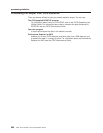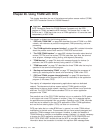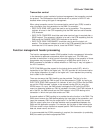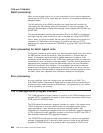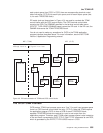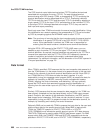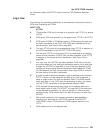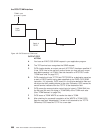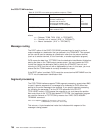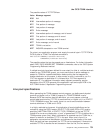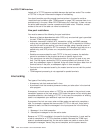The CICS terminal control table terminal entries (TCTTEs) define the terminals
associated with a particular line entry (TCTLE). For each physical terminal
communicating with CICS through TCAM, a corresponding TCTTE containing the
terminal identification must be associated with a TCTLE. Duplicating individual
TCTTEs for both the input TCTLE and the output TCTLE is avoided by attaching a
single, special TCTTE to the input TCTLE and attaching all the individual TCTTEs
to the output TCTLE. Although attached to the output TCTLE, they are used for
both input and output processing.
Each input record from TCAM must contain the source terminal identification. Using
this identification as a search argument, the corresponding TCTTE can be located
by CICS by comparing against the NETNAME value for each TCTTE.
Note: The usual way of ensuring that the input records contain the source terminal
identification is to specify OPTCD=W in the CICS DFHTCT TYPE=SDSCI
macro. If this specification is omitted, the TCAM user is responsible for
ensuring that the record contains a suitable source terminal identification.
Using the POOL=YES operand of the DFHTCT TYPE=LINE macro, you can
establish a pool of common TCTTEs on the output TCTLE that do not contain
terminal identifiers. As required, terminal identifiers are assigned to the TCTTEs or
removed from association with the TCTTEs. POOL=YES necessarily imposes a
number of restrictions and should be thoroughly understood before being
implemented. For additional information, see the discussion of the POOL operand in
“Line pool specifications” on page 701.
Data format
When TCAM is specified, CICS assumes that the user transaction data passed to it
from the TCAM queue is in the proper format to be passed directly to the user task.
Except for the removal of the source terminal identification and the 2-byte CCB (if
on a TCAM SNA line), CICS does not alter the data it receives. It is your
responsibility (using your message control program (MCP)) to prepare the data, for
example, by translating to EBCDIC, removing function management headers
(FMHs), stripping line control characters, and deblocking. You may optionally
bypass the CICS routine that removes the source terminal identification, by
returning from the user-written input exit (XTCTIN) in TCP with a displacement of 0
bytes.
Similarly, CICS assumes that the user transaction data passed to it for TCAM has
been properly formatted and can be placed directly on the TCAM output process
queue. Except for the insertion of the destination identification, the CCB, and the
data stream control characters, CICS does not alter the data it receives. It is your
responsibility (using your MCP) to prepare the data for the destination terminal, for
example, by translating and inserting line control characters.
Optionally, BMS can be used with TCAM to prepare the input data for the user task,
and the output data for the specific terminal type. When BMS is required with
TCAM, the TRMTYPE operand in DFHTCT TYPE=LINE or in DFHTCT
TYPE=TERMINAL must indicate the specific terminal type for 3270 data streams.
TRMTYPE=TCAM can be used to obtain EBCDIC data stream support. For BMS
support within SNA, the TCAMFET=SNA and SESTYPE operands must also be
specified in DFHTCT TYPE=LINE, and in DFHTCT TYPE=TERMINAL, respectively.
the CICS-TCAM interface
696
CICS TS for OS/390: CICS Customization Guide



